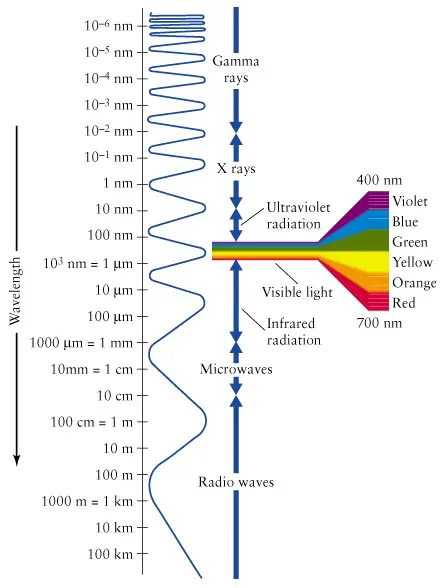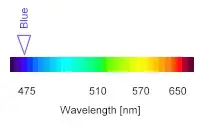Blue light is emitted by LED screens such as those used in cellphones, ipads, computer monitors, TVs, kid's video games etc. These LED screens have only been in wide use for a few years, so the effects of their use is just now becoming understood.
Here is what is emerging:
 Blue light from these devices may disrupt sleep patters
Blue light from these devices may disrupt sleep pattersOK, those are the headlines. But how real is this? Is this yet another example of the media pointlessly scaring people and opticians and eyeglass seller trying to profit by selling blue light filters?
 What
is Blue Light?
What
is Blue Light?Visible light, the light humans are able to see, is measured in the the range from 380 nanometers (nm) to 780 nm. Ultraviolet light (UV) starts just past the shorter end of the visible spectrum, meaning it is not visible to the human eye. Blue light is the range of visible light, which we see as the color blue, just before the ultraviolet light range begins. The visible blue light has a wavelength of about 475 nm. Because the blue wavelengths are shorter in the visible spectrum, they are scattered more efficiently by the molecules in the atmosphere. This causes the sky to appear blue. blue spectrum.
Related to blue light is Ultraviolate light. We include this not to confuse it with blue light, but to because it is closely related, as it is in the range of light radiation just past visible blue light. It is divided into 3 ranges: UVA, UVB and UVC.
Our bodies have their own biological clock, with it's own sleep/wake cycle, which is called the circadian rhythm. While each person has a slightly different circadian rhythm, the average length is 24 hours 15 minutes. Which also explains why, we go through periods when we tend to stay up later and wake up later - unless we reset the clock by exposure to sun light. And night owls tend to have circadian rhythms that are slightly longer (maybe 25.5 hours) that early birds who may be 23.5 hours. According to Harvard Medical School, research shows that disrupted sleep patterns may contribute to the causation of cancer, diabetes, heart disease, and obesity. Melatonin, a hormone that influences circadian rhythms, rises and falls throughout the day, and its levels are also related to exposure to light.
In Harvard's article, Stephen Lockley, a Harvard sleep researcher is quoted as saying even dim light, as low as 8 lux (click here for "what is Lux") can interfere with a person's circadian rhythm and melatonin secretion. For comparison, nightlights are usually around 4 lux.
Blue wavelengths of visible light help to reset our biological clock, which is why travel experts advise travelers to go outside in the morning after crossing many time zones. This helps to improve alertness, attention, reaction times, and mood. But at night, exposure to blue light can have the work against our sleep -wake cycle, making us feel more awake, when we need to be falling asleep.
Many studies have shown that people who work night shifts or have exposure to light at night, have higher rates of several types of cancer (breast, prostate), diabetes, heart disease, and obesity. The theory is that since exposure to light suppresses the secretion of melatonin, a hormone that influences circadian rhythms, and there's some experimental evidence (it's very preliminary) that lower melatonin levels might explain the association with cancer.
According to the American Macular Degeneration Foundation (AMDF) Ultra-violet and Blue Light Ultra-violet light (invisible light below 286nm to 400nm) is "generally understood to be harmful to the eye, possibly leading to cataracts and other eye diseases such as age-related macular degeneration (AMD)". The AMDF says recent studies suggest that the blue end of the light spectrum may also contribute to retinal damage and possibly lead to AMD. The retina can be harmed by high-energy visible radiation of blue/violet light that penetrates the macular pigment found in the eye. According to a study by The Schepens Eye Institute, a low density of macular pigment may represent a risk factor for AMD by permitting greater blue light damage.
Notice that they said "high-energy visible radiation of blue/violet light". Other authorities suggest that the risks may be exaggerated, since the personal electric devices emit very low levels, not high levels!
Since there are not yet adequate studies to determine dangerous vs. safe levels of exposure, the best approach is use reasonable and practical methods to reduce exposure. See below.
See the suggestions below. The links open relevant windows on Amazon.com to see examples.
Ways to save money AND help the environment:
Eat healthier AND save money: Instant Pot Duo Crisp 11-in-1 Air Fryer and Electric Pressure Cooker Combo with Multicooker Lids that Fries, Steams, Slow Cooks, Sautés, Dehydrates
Save water AND money with this showerhead adapter, it lets the water flow until the water is hot, then shuts off water flow until you restart it, ShowerStart TSV Hot Water Standby Adapter
Protect your health with these:
Mattress Dust mite-Bedbug protector, 100% Waterproof, Hypoallergenic, Zippered
Handheld Allergen Vacuum Cleaner with UV Sanitizing and Heating for Allergies and Pet, Kills Mite, Virus, Molds, True HEPA with Powerful Suction removes Hair, Dander, Pollen, Dust,
Immune Support Supplement with Quercetin, Vitamin C, Zinc, Vitamin D3
GermGuardian Air Purifier with UV-C Light and HEPA 13 Filter, Removes 99.97% of Pollutants
5 Stage Air Purifier, Features Ultraviolet Light (UVC), H13 True Hepa, Carbon, PCO, Smart Wifi, Auto Mode, Quiet, Removes 99.97% of Particles, Smoke, Mold, Pet Dander, Dust, Odors
Interesting Reads:
THE PREPPER'S CANNING & PRESERVING BIBLE: [13 in 1] Your Path to Food Self-Sufficiency. Canning, Dehydrating, Fermenting, Pickling & More, Plus The Food Preservation Calendar for a Sustainable Pantry
The Backyard Homestead: Produce all the food you need on just a quarter acre! Paperback
The Citizens' Guide to Geologic Hazards: A Guide to Understanding Geologic Hazards Including Asbestos, Radon, Swelling Soils, Earthquakes, Volcanoes
The Uninhabitable Earth: Life After Warming
Book: The Sixth Extinction: An Unnatural History Paperback